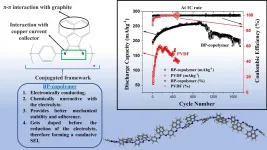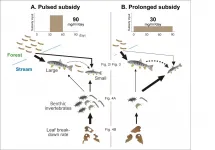(Press-News.org) Scars inside the abdomen, known as adhesions, form after inflammation or surgery. They can cause chronic pain and digestive problems, lead to infertility in women, or even have potentially life-threatening consequences such as intestinal obstruction. If adhesions develop, they must be operated on again. They also make subsequent surgical interventions more difficult. This leads to substantial suffering for those affected and is also a significant financial burden for the healthcare system. In the USA alone, adhesions in the abdomen result in healthcare costs of 2.3 billion dollars per year.
Knowledge about the cause of adhesions is still incomplete, and there no therapy for them. "Because the disease has been largely overlooked in research, we have started this program in Bern to find out more about the development of adhesions," says Daniel Candinas, Co-author of this study. It had already been suspected that special immune cells, called macrophages, play a decisive role in the development. This was confirmed by Joel Zindel and Daniel Candinas from the Department of Visceral Surgery and Medicine at Inselspital and Department for BioMedical Research (DBMR) at the University of Bern.
Then, Zindel continued his research at the University of Calgary in Canada in the group led by Paul Kubes, as they are considered world-leading in the field of macrophages in the abdominal cavity. Thanks to Zindel's clinical expertise and the Canadian researchers' know-how, it was possible to develop a new imaging system using cutting-edge microscopy that allows to see inside the living body. This allowed them to catch the macrophages in flagrante and on film, as they form shapes that then lead to the adhesions.
The researchers were also able to describe the molecular mechanisms behind this. The results of the study have now been published as the cover story of the journal Science.
New technology developed
Macrophages are found in what is called peritoneal fluid, a lubricant between the peritoneum, which is inner lining of the abdominal wall, and a similar lining around the organs in the abdominal cavity. Macrophages passively swim around in this fluid, much like plankton in the sea. Their tasks include eliminating pathogens, but also sealing injuries in the abdominal cavity as quickly as possible.
How they accomplish the latter, i.e., recognizing an injury and moving there, was unclear until now. Since these cells behave in the test tube very differently from the way they do in the body, Zindel and Kubes developed a new microscopy technique that allowed them to use the thinnest part of the abdominal wall as a window to look into the peritoneal caity, the "native habitat" of these macrophages and film them as they move arround.
When macrophages lose control
When there is an injury within the abdominal cavity, macrophages aggregate within minutes to form clot-like structures. In this way, they seal the injury. As the researchers led by Zindel and Kubes have discovered, the molecular mechanism behind this is based on special, non-specific receptors that recognize a variety of structures. Simply by being moved through the fluid via respiratory or digestive movement, these receptors act to initiate clotting around a wound. What works fine for smaller injuries becomes a problem for large ones, however, such as surgically opening the abdominal wall, or inserting an implant. "In larger injuries, the macrophages get out of control - the clots don't stop growing and form long strands," Zindel explains. "We were able to show that these strands are what lead to the adhesions."
This could have evolutionary reasons: Macrophages are optimized by evolution to cope well with small injuries. "Let's take the example of a hunter who is injured by a deer antler," Zindel says. "The macrophages seal all the internal holes as quickly as possible - which is the only way to survive." However, when air enters the abdominal cavity during abdominal surgery or foreign bodies are implanted, the macrophages are overwhelmed because evolution has not prepared them for this challenge. "In this case, the macrophages become harmful and cause adhesions," Zindel explains.
Patent pending
The researchers found that when the corresponding receptors are blocked in mice, it leads to fewer adhesions. Thus, a patent application has been filed for the use of the active ingredient against adhesions. The findings are relevant to many areas of research, as there are no other immune cells which are being recruited as quickly as macrophages in the abdominal cavity. Similar mechanisms could be present in other cavities such as the heart or lungs, or could play a role not only in injuries but also diseases such as abdominal tumors.
"This is an example of how laboratory research has high translational value," says Daniel Candinas. Together with Calgary, the Bernese researchers will now look for partners in the industry and are hopeful that they will be able to confirm the efficacy of the compound in human tissue as well. In the future, patients could, for example, be given a drug before surgery that suppresses the macrophage reaction and inhibits the formation of adhesions.
INFORMATION:
Researchers from the University of Seville and Pompeu Fabra University argue that sports information on social media is dominated by men and football. This leaves out women's sports, sports featuring athletes with disabilities and minority disciplines, thus repeating the reality of the traditional media. That is the main conclusion of a study analysing more than 7,000 tweets published by the profiles of four public media in four European countries.
The study analysed the posts by the Twitter profiles providing sports news of the public broadcasters of Spain (RTVE), France (France TV), Ireland (RTÉ) and Italy (RAI). Between 30% and 58% of the tweets by these media related to football. However, differences were observed ...
As the source of most of the water we drink and a place where we often go to recreate and enjoy nature, streams represent a crucial point-of-contact between human beings and the environment.
Now researchers in the College of Natural Resources and Environment and the Department of Biological Systems Engineering are using stream quality data to find new insights into the interactions between the health of our natural spaces and human well-being.
Their findings, published in the journal Ecological Indicators, reveal that demographics such as race and population density, as well as health indices such as cancer rates and food insecurity, show strong correlations with water quality across the Commonwealth of Virginia.
"We started off wanting to explore the general, intuitive ...
In recent years, therapeutic antibodies have transformed the treatment of cancer and autoimmune diseases. Now, researchers at Lund University in Sweden have developed a new, efficient method based on the genetic scissors CRISPR-Cas9, that facilitates antibody development. The discovery is published in Nature Communications.
Antibody drugs are the fastest growing class of drug, and several therapeutic antibodies are used to treat cancer. They are effective, often have few side effects and benefit from the body's own immune system by identifying foreign substances in the body. ...
Researchers in the UK have developed a way to coax microscopic particles and droplets into precise patterns by harnessing the power of sound in air. The implications for printing, especially in the fields of medicine and electronics, are far-reaching.
The scientists from the Universities of Bath and Bristol have shown that it's possible to create precise, pre-determined patterns on surfaces from aerosol droplets or particles, using computer-controlled ultrasound. A paper describing the entirely new technique, called 'sonolithography', is published in Advanced Materials Technologies.
Professor Mike Fraser from the Department of Computer Science at the University of Bath, explained: "The power of ultrasound has already been shown to levitate small ...
Anyone who has owned a smartphone for over a year is most likely aware that its built-in lithium (Li)-ion battery does not hold as much charge as when the device was new. The degradation of Li-ion batteries is a serious issue that greatly limits the useful life of portable electronic devices, indirectly causing huge amounts of pollution and economic losses. In addition to this, the fact that Li-ion batteries are not very durable is a massive roadblock for the market of electric vehicles and renewable energy harvesting. Considering the severity of these issues, it is no surprise that researchers have been actively ...
In recent years, researchers have begun using functional magnetic resonance imaging (fMRI) not just for better understanding the neural bases of psychiatric illness, but also for experimental treatment of depression, ADHD, anxiety, PTSD, substance use disorder, and schizophrenia with a technique called real-time fMRI neurofeedback.
While rtfMRI-NF has emerged in recent years as a promising experimental intervention, it's also a costly procedure that requires extensive technical setup to allow for real-time analysis. That's why a quantitative data review was overdue.
A team of END ...
In the brain, billions of neurons reach to each other, exchanging information, storing memories, reacting to danger and more. Scientists have barely scratched the surface of the most complex organ, but a new device to automatically collect tissue for analysis may allow for a quicker, deeper dive into the brain.
Their approach was published in IEEE/CAA Journal of Automatica Sinica, a joint publication of the IEEE and the Chinese Association of Automation.
"The ultimate goal of this study is to further promote the speed and quality of 3D-reconstruction of brain neural connections," said the author Long ...
Insects that fall from the surrounding forest provide seasonal food for fish in streams. Researchers at Kobe University and The University of Tokyo have shown that the lengthening of this period has a profound effect on food webs and ecosystem functions present in streams.
These research results provide proof that changes in forest seasonality also affect the ecosystems of nearby rivers. This finding highlights the importance of predicting the effects of climate change on ecosystems.
The research group consisted of Associate Professor SATO Takuya and post-graduate student UEDA Rui of Kobe University's Graduate ...
In a new study by the Yale Department of Immunobiology and Yale Cancer Center, researchers report combined liver and growth factor humanization enhances human red blood cell production and survival in circulation the immunodeficient murine host. The discovery could help in the development of treatments of life-threatening blood disorders, such as myelodysplastic syndrome, and diseases afflicting red blood cells, including sickle cell disease and malaria. The study is published online today in the journal Science.
"Red blood cell diseases, such as thalassemia and sickle cell disease involve approximately 5% of ...
Professor Byoungwoo Kang develops a high-density cathode material through controlling local structures of the Li-rich layered materials.
Researchers in Korea have developed a high-capacity cathode material that can be stably charged and discharged for hundreds of cycles without using the expensive cobalt (Co) metal. The day is fast approaching when electric vehicles can drive long distances with Li- ion batteries.
Professor Byoungwoo Kang and Dr. Junghwa Lee of POSTECH's Department of Materials Science and Engineering have successfully developed a high energy-density cathode material that can stably maintain charge and discharge for over 500 cycles without the expensive ...






